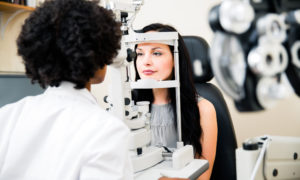By Cheryl G. Murphy, OD

June 17, 2015
When I changed jobs recently, I moved from apractice that used paper charts to one that is virtually paperless. At first, the thought of going paperless was frightening. I was a doctor who was trained on paper charts and loved walking around the office with my trusty pen in hand.I soon becamemore comfortable with electronic health records, and I see their many advantages, specifically in how they make my exams more efficient.
One of the biggest ways EHR has helped me is by making me a more efficient coder. In the program I am using (Officemate’s ExamWriter), coding is generated almost automatically, based on your exam findings. For example, let’s say you document papillae on palpebral conjunctiva under slit lamp observations, an array of possible diagnoses will pop up when you click on your impression/assessment. Once you check off the appropriate diagnosis, it will be added to your assessment and a list of possible treatment options will be generated from which you can select the most appropriate. This diagnosis is then automatically copied to your coding and a recall schedule can be selected. No more memorizing or looking up diagnosis codes in mangled coding books or online. EHR makes documenting and coding eye health problems fast and easy. Also, no more needing to write findings, assessments, plans, instructions and recall information out by hand; with a series of clicks on the EHR, it is all documented for you.
EHR has also made me more efficient in patient education, which I have always prided myself on. I still spend plenty of time talking to my patients, butbecause of our patient portal, I now feel I can spend a little less time reiterating important points. After an exam with us, our office sends a secure e-mail outlining the patient’s exam findings, the doctor’s impressions and what they mean and how we plan on treating each condition. I tested this out on myself after my exam, and it was really great.
My e-mail summary gave a good explanation for myopia and what we were going to do to treat it. In the case of the papillae, let’s say it was allergic conjunctivitis, the e-mail would give instructions to the patient on trying to avoid the allergen if possible, what allergic drop we prescribed and how/when to take it and the option of doing cool compresses for further relief of redness and itch. Having all of these instructions sent in an e-mail, instead of being expected to memorize them while the doctor is talking, seems much easier on the patient. As a patient myself, I have been offered the option of patient portals with e-mailed testing summaries at other physicians’ offices, so it makes sense for optometry to keep current with this new trend in medicine.
It has been a full month now since I started using EHR, and I have gained confidence using it. In the beginning, it can be an intimidating adjustment if you are used to paper charts, but here are tips to help you, or your newly hired associate, ease into EHR:
Watch your own patient chart get inputted. Become the patient yourself, and have a colleague, who already uses EHR, input your exam, so you can see the process start to finish. You then can play around with your own chart on the computer to familiarize yourself with the various fields and menus.
Watch user tutorials. Some EHR companies put employee training video tutorials online. They can be extensive, and may take hours to get through, but this is one of the best ways to familiarize yourself with the format and functionality of the software before diving into it.
Allow for extra time in the beginning. Consider increasing the time you are allotted with each patient in the beginning to give yourself time to learn the system. If this is not possible, you could have paper and a pen ready, but only reach for it if you find yourself struggling and falling too far behind schedule.
Ask questions. Don’t be afraid to ask many questions, especially of the optometrists in your practice who are familiar with the EHR exam format. Technicians and office managers may also be helpful in learning the computerized scheduler, recall system, looking up patient demographics or previous history of prescriptions, testing and purchases.
Read the choices. In the beginning it takes time to familiarize yourself with the different checklists and formats on the EHR. Give yourself a few extra seconds to read through the choices, even if it means the patient waits for a few seconds. Familiarizing yourself with the menus will help you to feel more comfortable with them in the long run.
Explore in your spare time. When you aren’t seeing patients, go back under a chart you still have open, or even one you have closed, and click around. Double-check your work and make sure you have filled in everything as precisely as you wanted to document it.
Give yourself a break. Don’t be hard on yourself if in the beginning if you find it tough and a little scary. My employer kept telling me I am doing great and that I could do this, and you know what? She was right. Her encouragement and support really relaxed me, and soon I was even saying it confidently to myself: I can do this!
With a little patience, prep work and time, you too will be able to master EHR.
What is your experience with EHR? How do you train employees who have little-to-no experience with it? Do you prefer it over paper and pen? What benefits has EHR brought you?
Cheryl G. Murphy, OD, practices in Babylon, NY. You can like her on Facebook or follow her on Twitter @murphyod. To contact her: murphyc2020@gmail.com.



























